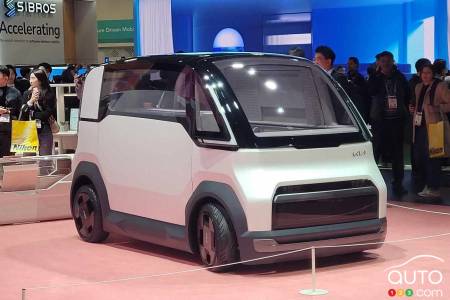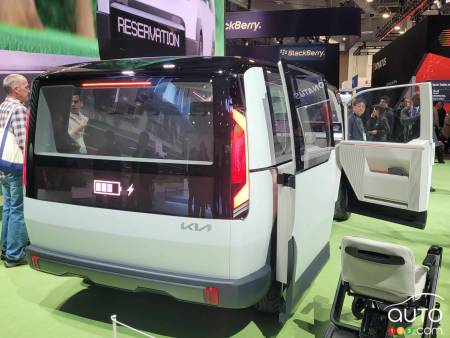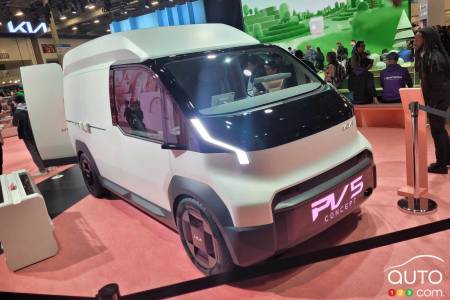Las Vegas, NV — After a five-year absence from the Consumer Electronics Show (CES) in Las Vegas, Kia made a notable comeback with the presentation of a highly flexible new electric vehicle platform (PBV), accompanied by five new concepts set to debut soon.
These models will primarily be commercial with businesses as the main customers, but they will be available for purchase by individuals.
Of the five models, three belong to the same family called PV5. The other two are PV1 and PV7, located at opposite ends of the size spectrum.
The letters PBV (Platform Beyond Vehicle) are there to identify the structure of these vehicles, designed to redefine mobility for businesses with an unparalleled level of versatility.

A futuristic design, for the present
The first thing that catches the eye with all these models is their very futuristic design. It was intentionally designed as such, as confirmed by Karim Habib, Executive VP and Head of Global Design at Kia.
However, at the heart of Kia’s priorities was space and versatility. The goal, to create highly customizable vehicles capable of meeting ever-growing and varied consumer needs.
The PV5 model's structure is actually centered on a chassis-cab, similar to those used for trucks and vans. Kia says that behind the cab, a multitude of modules can be attached, turning the vehicle into a pickup truck, bus, or even a van with ample cargo space.
Ample is right. With each vehicle, there are very large doors that open at wide angles (or slide open fully) to reveal a pillarless interior that facilitates entry and exit. The extended wheelbase and electric structure ensure maximum clearance, providing numerous possibilities for interior customization.
In the passenger version, for example, second-row seats can be deployed to face forward or backward. They can even be positioned vertically to free up space for a small wheelchair, thanks to an integrated access ramp.

This design element, a particular point of pride for Habib, ensures greater accessibility for those with reduced mobility in a model right out of the factory, without need to call on an outside company for vehicle modification.
Solar panels, integrated into the panoramic roof, can power the vehicle's battery and a power bar for various devices. As a fun feature that demonstrates how much thought has been given to the future functions of this vehicle, the steering wheel, when not in use, can deploy vertically to become a work lamp.
This video shared by Kia shows the impressive possibilities allowed by the flexible PV5 design.
Kia is also proud to have integrated sustainability into the heart of the design. It is, in fact, central to the PBV design strategy. Thus, the intensive use of materials such as bioplastic, organic paint, fabric, felt, and recycled components not only limits environmental impact but also offers a different and futuristic environment.
One platform, multiple vehicles?
Kia's CES video presentation shows that the interchangeability of modules behind the cab allows a single vehicle to take various forms and serve various functions. The company says different interchangeable modules behind the cab can be connected to the vehicle via electromagnetic and mechanical coupling technology, transforming the vehicle “into a taxi during the day, a delivery van in the evening, and a personal recreational vehicle on weekends.”
The idea is brilliant, and the possibilities are extraordinary. However, when we asked Kia representatives about it, it was clear this is going to happen right away, and also that it won’t be possible initially to transform vehicles DIY, at home. We can assume that that’s the company’s ultimate wish, but it will be in subsequent phases of development.

Moreover, while Kia presented several models this week, their deployment and the development of their capabilities will take place over several years through three distinct phases:
• Phase 1: Customizable fleets for increased efficiency for businesses (time and economies of scale).
• Phase 2: Highly connected and updated PBV vehicles to serve more areas and meet user lifestyles.
• Phase 3: A new era of solutions for all businesses and lifestyles through the redefinition of space and mobility concepts.
Phase 1 will be upon us quickly, the first models expected to be ready in 2025. Those will be assembled in a new factory Kia is building in Hwaseong, South Korea. Initial production capacity will be 150,000 units annually, increasing gradually to 300,000.
As for the Canadian market, we can expect to see the first Kia PV5 models arrive in 2026. The PV7 (larger, more spacious) and PV1 (very compact, possibly fully autonomous) models will follow.

Phase 2 will take shape from around 2027, while Phase 3 is expected to occur sometime in the 2030s if everything evolves as the company hopes.
And to give an idea of what may eventually await owners of a fleet consisting of PBV models, imagine a vehicle that knows all the packages it needs to deliver (having the address of each) and organizes a route based on the equipment it carries. Moreover, thanks to a rail system, it will be possible to transfer equipment from one PVB to another automatically.
Everything is designed to reduce downtime and improve profitability.
As for Phase 3, welcome to the future. Kia envisions a world where it would be possible, for example, to have your office in a module that can moved by an interconnected system wherever you want, whether at the office for work or in the heart of a park for a moment of relaxation. The city of the future, in a way, where all our movements are reimagined.
The final word
Kia's presentation at CES had a surreal touch, almost literally opening a window into the future. However, it's this kind of innovation that shapes and defines the future. It can be unsettling, too, as it challenges established models. At the same time, it presents extraordinary growth opportunities... provided you keep an open mind.
One thing at a time, though, starting with the arrival of the Kia PV5, sometime in 2026.




